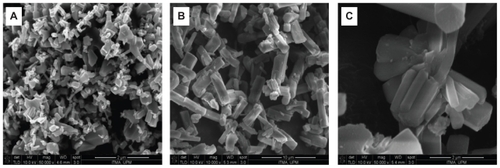 ?Mathematical formulae have been encoded as MathML and are displayed in this HTML version using MathJax in order to improve their display. Uncheck the box to turn MathJax off. This feature requires Javascript. Click on a formula to zoom.
?Mathematical formulae have been encoded as MathML and are displayed in this HTML version using MathJax in order to improve their display. Uncheck the box to turn MathJax off. This feature requires Javascript. Click on a formula to zoom.Abstract
An ellagic acid (EA)–zinc layered hydroxide (ZLH) nanohybrid (EAN) was synthesized under a nonaqueous environment using EA and zinc oxide (ZnO) as the precursors. Powder X-ray diffraction showed that the basal spacing of the nanohybrid was 10.4 Å, resulting in the spatial orientation of EA molecules between the interlayers of 22.5° from z-axis with two negative charges at 8,8′ position of the molecules pointed toward the ZLH interlayers. FTIR study showed that the intercalated EA spectral feature is generally similar to that of EA, but with bands slightly shifted. This indicates that some chemical bonding of EA presence between the nanohybrid interlayers was slightly changed, due to the formation of host–guest interaction. The nanohybrid is of mesopores type with 58.8% drug loading and enhanced thermal stability. The release of the drug active, EA from the nanohybrid was found to be sustained and therefore has good potential to be used as a drug controlled-release formulation. In vitro bioassay study showed that the EAN has a mild effect on the hepatocytes cells, similar to its counterpart, free EA.
Introduction
Systemic drug delivery leads to distribution of the drug throughout the body through blood circulation, which can lead to drug concentration accumulation in unwanted parts of the body that causes severe side effects. Additionally, conventional drug administration methods do not provide satisfactory pharmacokinetic profiles because the drug concentration rapidly falls below the desired levels.Citation1 Cancer chemotherapy is the treatment of cancer cells with an antineoplastic drug. The main property of cancer cells is rapid division. Chemotherapy acts by killing cells that divide rapidly, which means it also harms cells that divide rapidly under normal circumstances such as cells in the bone marrow, digestive tract, and hair follicles, producing side effects such as myelosuppression,Citation2 mucosities,Citation3 and alopecia.Citation4 To overcome these side effects, researchers are now searching for efficient and safe transport carriers, which prolong exposure time to drugs and target cancerous cells without targeting healthy cells.
In the past few decades, many carriers have been developed, and generally can be classified into four major groups: viral carriers, recombinant proteins, organic cationic compounds, and inorganic nanoparticles.Citation5,Citation6
Recently, inorganic nanoparticles have attracted considerable attention due to their versatile features, such as wide availability, good biocompatibility, rich surface functionality, potential capability of target delivery, and controlled release of the drug from the inorganic nanoparticles.Citation7–Citation9 Calcium phosphate, gold, carbon nanotubes, silicon oxide, iron oxide and layered double hydroxides are examples of inorganic nanoparticles, which have intensively investigated in different studies by different groups.Citation10–Citation15 Layered double hydroxides (LDH) are materials with a number of advantages for drug delivery. Among these are their ease of laboratory preparation with a controlled particle size,Citation16 and the drugs can be easily loaded into the interlayers space by ion exchange, comparing with other nanoparticles which need further modification such as surface functional modification.Citation17,Citation18 Layered double hydroxides have a high zeta potential, 20–30 mV, which provides a strong driving force on to the surface of a cell. LDH are degraded in an acidic environment to form M2+, M3+, and X− ions which leads the drug actives leaving the cell through the ion-tunnels, whereas the others inorganic nanoparticles accumulate in the cells because of their low solubility in the cells. Low cytotoxicity is another virtue of LDH. Hussein et al reported that there is no toxic effect of Zn–Al LDH at low concentration on Chinese hamster ovary cells.Citation19
LDH, also known as hydrotalcite-like compounds, are formed by layered units in which metal cations are octahedrally coordinated with hydroxyl groups, as in the brucite (Mg(OH)2) structure. The isomorphic substitution of divalent cations by trivalent cations leaves a residual positive charge that is stabilized by inter layer anions. The general formula for hydrotalcite is [M2+1–xM3+x (OH)2]x+ (Am−)x/m·nH2O, where M2+ is divalent cations, M3+ is trivalent cations and Am− is exchangeable anion with charge (m−).Citation20 Similar to LDH, zinc layered hydroxide (ZLH) is a compound whose structure derived from brucite. One quarter of the octahedral coordinated zinc cations are displaced from the main layer to tetrahedral sites located above and below each empty octahedron and can be represented by the general formula M2+ (OH)2–x (Am−)x/m·nH2O, where M2+ is the Zn2+ and Am− is counter ions with (m−) charge.Citation21
Because of ZLH anionic exchange capacity, many active compounds can be intercalated into ZLH interlayers. These include the anticarcinogenic agent gallic acid,Citation22 linoleic acid,Citation23 sunscreen materials such as 2-amino benzoic acid and 4-amino benzoic acid,Citation24 nucleoside monophosphate, DNA,Citation25 and pharmaceutical, cosmeceutical, and nutraceutical compounds.Citation26
Various methods have been adopted for preparation of ZLH and its nanohybrids, namely hydrolysis of salt and oxides,Citation27 urea hydrolysis,Citation28 precipitation with alkaline solutions,Citation29 and solid state reaction.Citation30 Direct reaction of zinc oxide (ZnO) is simple and easily used either for aqueous or nonaqueous systems. Such a method is economic and environmentally friendly as fewer steps and chemicals are involved.
Ellagic acid (EA) is an antioxidant, which is a family of drugs much used for cancer treatment. Intense research has been conducted to investigate the effect of EA on the cancer cell as well as its delivery.Citation31–Citation34 Lately, many articles have described the preparation of ZLH as a starting material followed by intercalation of the anion. However, to the best of our knowledge, little work has been published on the use of ZnO as a starting material to intercalate drug actives.Citation35,Citation36 Therefore, the main objective of this work was to explore the potential use of ZnO as a starting material for the intercalation of EA for the formation of a new EA–ZLH nanohybrid (EAN). The resulting nanohybrid was then used as a controlled release formulation of drug active EA. A cytotoxicity study of nanohybrids was also carried out.
Experimental
Materials
All chemicals used in this study were of analytical grade and used without any further purification. Hydrated EA (97% purity) was purchased from Sigma-Aldrich (St Louis, MO) and pure commercial ZnO of ACS reagent was used, purchased from Fisher Scientific (Waltham, MA). Dimethyl sulfoxide (DMSO) was purchased from Ajax Finechem (Sydney, Australia) with 0.1% water content used as solvent.
Method
Typically, the appropriate amount of hydrated EA (0.0013 mol) was dissolved in DMSO followed by 10 minutes stirring and heating for 40°C. The ZnO (0.2 g) was mixed with the solution of EA and stirred at 70°C for 8 hours. After filtration and washing with deionized water three times, the sample was dried in an oven at 60°C for 12 hours. The resulting material was then powdered and stored in a sample bottle for further use and characterization.
Characterization
Powder X-ray diffraction (PXRD) patterns were recorded at a range of 2–60° on a Shimadzu diffractometer, XRD-6000 (Tokyo, Japan) using CuKα radiation at 40 kV and 30 mA. Fourier transform infra-red (FTIR) spectra of the materials were recorded over the range 400–4000 cm−1 on a Perkin-Elmer 1752X spectrophotometer (Waltham, MA) using a KBr disc method. For carbon, hydrogen, nitrogen and sulfur (CHNS) analyses, a CHNS-932 model of LECO instrument (St Joseph, MI) was used. Thermogravimetric and differential thermogravimetric analyses (TGA-DTG) were carried out using a Mettler Toledo instrument (Greifensee, Switzerland). Surface characterization of the material was carried out using a nitrogen gas adsorption–desorption technique at 77 K using a Micromeritics ASAP 2000 (Norcross, GA). The surface morphology of the samples was observed by a scanning electron microscope (SEM), using JOEL JSM-6400 (Tokyo, Japan). UV-Vis spectra for optical properties and controlled-release study were accomplished using a Perkin Elmer UV-Vis Spectrophotometer, Lambda 35.
Controlled-release study
Drug release profiles were determined at room temperature by using 0.1 M Na2CO3Citation37 and Na3PO4Citation38 solutions. Both anions CO3−2, PO4−3 are commonly used for preliminary study of drug release, to observe the controlled-release property of the intercalated drug actives. This was also conducted to study the effect of different negative species CO3−2, PO4−3 on the rate of release. The UV-Vis spectrum of DMSO and EA dissolved in DMSO shows intense absorbance at 224.0 and 257.5 nm, respectively. Therefore, DMSO is an interference-free solvent. The EA released was measured at a predetermined time by UV-Vis spectrophotometer at 257.5 nm.Citation39 The EA release kinetics was fitted to four models, as shown in .Citation40–Citation43
Table 1 Physicochemical properties of ZnO and ZLH-nanohybrid, EAN
Table 2 Correlation coefficient, rate constant, and half time obtained by fitting the data of the release of EA from EAN into 0.1 M Na2CO3 and 0.1 M Na3PO4; the equation of kinetic models used for the fitting is also indicated
In vitro bioassay
The cytotoxicity effect of ZnO, EA, and EAN against healthy rat hepatocytes was examined by a cell viability test. Hepatocytes from normal healthy Sprague Dawley rats (n = 4) were isolated by a two-step collagenase perfusion technique.Citation44–Citation46 Viability of freshly isolated rat hepatocytes was determined by trypan blue exclusion. After isolation, hepatocytes suspensions were incubated at a density of 1 × 106 viable cells/mL in Leibovitz Glutamax I (L-15 incomplete) medium. About 25 μg/mL EA, EAN, and ZnO were added to DMSO (final DMSO concentration of 1.0% v/v). Control hepatocytes suspensions were incubated with an equivalent amount of DMSO. The flasks were sealed in 95% O2/5% CO2 and placed in a shaking water bath at 37°C. Samples were taken from these flasks at time points of 0, 0.5, 1, 3, and 6 hours for a viability test.
Viable cells were determined by lactate dehydrogenase activity in medium and in the lysed cells at each time point. The activity was assessed spectrophotometrically as described by Marshall and Caldwell.Citation45
Results and discussion
PXRD and EA orientation between ZLH interlayers
show PXRD patterns of ZnO, EAN, and EA, respectively. For ZnO sample, the five intense reflections shown in at 30–60° correspond to diffractions due to 100, 002, 101, 102, and 110 planes. shows the PXRD pattern of EAN synthesized by direct reaction between 0.025 M hydrated EA with ZnO. As reported in the literature, the zinc hydroxide nitrate has sharp reflection at 9.7 Å due to the 200 plane of the monoclinic structure.Citation47,Citation48 After the intercalation of the anions, the basal distance increased more than 9.7 Å due to the displacement of exchangeable nitrate anions and depending on the dimensions and the spatial orientation of the guest anion that is intercalated into the ZLH inorganic interlayers.Citation48 As shown in the , the formation of the EAN can be confirmed by the observation of two new diffraction patterns at d = 10.4 Å and 5.2 Å, which is due to 003 and 006 reflection, respectively. Total disappearance of the intense peaks of ZnO phase indicated that the sample EAN is pure phase and the ZnO was completely converted to ZLH.Citation36
Figure 1 PXRD patterns of ZnO (A), EAN (B) and EA (C).
Abbreviations: PXRD, powder X-ray diffraction; EA, ellagic acid; EAN, ellagic acid nanohybrid.

The formation of EAN is believed to occur through a dissociation–deposition mechanismCitation36,Citation49 which takes place in the nonaqueous solution of hydrated EA. The mechanism is composed of three steps:
Hydrolysis of ZnO in water into hydrated EA to form Zn(OH)2 on the surface of the solid particles
Formation Zn2+ species by dissociation of Zn(OH)2
In addition, reaction between Zn2+ ions formed with hydroxyls, H2O and EA anions in the solution generate the layered nanohybrid compound,
The EA has the molecular structure of a planar phenolic lactone that is doubly deprotonated at positions 8 and/or 8′ when the pH is more than 5.6.Citation50 shows the three-dimensional molecular size of EA obtained using Chemoffice software (Cambridge, MA).
Figure 2 Molecular structure of EA and three-dimensional molecular size of EA (A) and spatial orientation of EA in ZLH inorganic interlayers (B).
Abbreviations: EA, ellagic acid; ZLH, zinc layered hydroxide.

shows that the thickness of the ZLH is 4.8 ÅCitation51 and d-spacing of the ZLH samples intercalated by EA from XRD spectrum is 10.4 Å. Therefore, the gallery height avialable to be occupied is 5.6 Å, which is smaller than 12.4 Å or 9.8 Å, the dimension of EA. In addition, the thickness of two molecules of EA is about 5.8 Å, which is bigger than the gallery height. This means that the EA has to be oriented between the interlayers as a monolayer and the spatial orientation of the molecule is with an angle of 22.5° from z-axis as shown in .
FTIR spectroscopy
The FTIR spectra of the EAN nanohybrid and EA are given in . The FTIR spectrum of EA shows an absorption band at 3557 cm−1, attributed to the stretching mode of OH groups in the phenol at 7,7′, 8 and 8′ positions ()Citation52 and broad absorption bands at 3500–2750 cm−1 can be attributed to stretching of C–H aromatic ringCitation24 and hydrogen bond between EA molecules.Citation50 A band at 1700 cm−1 is due to stretching of C=OCitation52,Citation53 and bands at 1620–1511 cm−1 are due to aromatic rings. A band at 1196 and 1058 cm−1 is due to ester linkage of C–O stretchingCitation34,Citation52 and another band at 758 cm−1 is due to C–H aromatic stretching.
Figure 3 FTIR spectrum of EA (A) and EAN (B).
Abbreviations: FTIR, Fourier transform infra-red; EA, ellagic acid; EAN, ellagic acid nanohybrid.
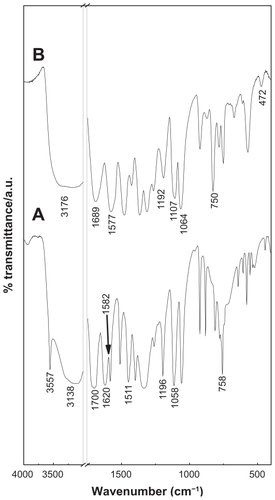
FTIR spectrum of EAN () shows characteristic bands of pure EA together with other band of ZLH. This indicates that the EA has been intercalated into the interlayer galleries of ZLH. Band for C=O, C–O ester linkage and C–H aromatic are slightly shifted in position to 1689, 1064, 750 cm−1, respectively, due to the interaction between EA and the host interlayers as a result of the intercalation process. A broad absorption band observed at 2500–3600 cm−1 is attributed to OH stretching due to the presence of hydroxyl group within the ZLH and phenolic hydroxide at position 7,7′.Citation50 A band at 1577 cm−1 can be attributed to C=C stretching vibration of aromatic,Citation52 and a band for ν(C–O) can be observed at 1107 cm−1 and ν (Zn–O) absorption bands at 472 cm−1. This indicates that the EA is coordinated to the inorganic layers by the negatively charged oxygen atoms at positions 8 and 8′.Citation50,Citation54 The successful intercalation of EA into ZLH can be supported by CHNS analysis as shown in . EAN shows 32.7% carbon (w/w) and 2.6% (w/w) hydrogen, resulted in loading percentage of EA in the nanohybrid of about 58.8%. Elemental analysis using ICP/AES shows EAN contains 29.3% Zn (w/w).
Thermal analysis
TGA-DTG thermogravimetric analysis obtained for EA and EAN is shown in . The TGA-DTG thermograms of EA () show the first step weight loss, which can be attributed to the removal of bonded water with hydrogen bond at temperature maxima of 112°C (8.2%). The onset of weight loss of EA occurs at 381°C with two steps weight loss at 463°C (39%) and 596°C (17.5%). Because of the intercalation, the shape of the TGA-DTG curves () is changed. The first weight loss at 78°C in the DTA curve corresponding to the absorbed water. The absence of a band at 1600 cm−1 in the FTIR spectrum confirming the absence of water between the interlayers.Citation55 The onset of dehydroxylation of zinc hydroxide layers and decomposition of EA occurs at around 496°C, with a rapid weight loss occurring in the temperature range at 496°C–819°C with two steps at 585°C (24%) and 714°C (25.2%). These temperatures are higher than the decomposition temperature of pure EA. This result indicates that the inorganic layers of ZLH enhanced the thermal stability of EA, the organic moiety.
Surface properties
Nitrogen adsorption–desorption isotherm for ZnO and EAN are shown in , shows features which can be described as Type IV in IUPAC classification, indicating mesopores-type material.Citation56 The adsorption of ZnO and EAN increased slowly at low pressure in the range of 0.0–0.8, followed by rapid adsorption of the absorbent at relative pressure of 0.8 and above. The desorption branch of the hysteresis loop for ZnO is much narrower compared to EAN, indicating different pore texture of the resulting materials. This is due to the formation of ZLH with a basal spacing of 10.4 Å as well as the formation of interstitial pores.Citation57 As a result of nitrogen adsorption study, we obtained the Breuneur, Emmet, and Teller (BET) surface area of the materials as shown in . The intercalation of EA into ZLH for the formation of EAN resulting in the decrease of the surface area from 6.4 m2/g for ZnO to 3.6 m2/g for EAN. This is attributed to the increase in the particles size and decrease of the pore volume.
Figure 5 Adsorption–desorption isotherms (A) and BJH pore size distribution (B) for ZnO and EAN.
Abbreviations: BJH, Barret–Joyner–Halenda; EAN, ellagic acid nanohybrid.

Barret-Joyner-Halenda (BJH) pore size distribution for ZnO and EAN are shown in . Both materials show mesopores character, in agreement with the adsorption isotherm of Type IV. BJH pore size distribution of ZnO () shows different features to that of EAN, indicating that the pore texture was modified, which is in agreement with the formation of EAN with a basal spacing of 10.4 Å. The BJH pore diameter of ZnO is lower than that of EAN. The increase from 111 to 170 Å is as a result of the intercalation of EA into the interlayer of ZLH.
Surface morphology of the samples, studied by field emission SEM for ZnO and EAN are shown in . ZnO reveals nonuniform granular structure without any specific shape, with various sizes and shapes (). This structure was transformed into rod-like agglomerates with nonuniform size and shapes as shown in , when the intercalation of EA into the interlayer of ZLH had taken place.
Optical properties
UV-Vis spectroscopy was used to investigate whether the intercalation of EA into the ZLH host resulted in changes in its optical properties. shows the UV-Vis spectra of pristine EA as well as EAN. It can be seen that pristine EA exhibits a strong absorption band at 350 nm with a shoulder at 370 nm, corresponding to the μ → μ* transition of EA. When EA was intercalated into ZLH interlayers, the 370 nm band was slightly increased in intensity, indicating doubly deprotonated EA between the interlayers.Citation50 This verifies that the drug molecules are stabilized by electrostatic interaction with the positive charge of ZLH.
Figure 7 Solid-state UV-Vis spectra of pure EA and its nanohybrid, EAN (A) and their Kubelka-Munk plot of EA, EAN and ZnO (B).
Abbreviations: EA, ellagic acid; EAN, ellagic acid nanohybrid.
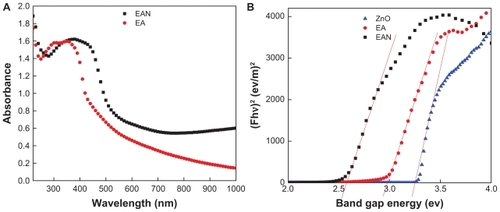
In order to estimate the energy band gap, the Kubelka– Munk (K–M) Equationequation (1)(1) was adopted,Citation58
where F is the K–M, h is Bohr constant, Eg is the energy band gap in electron volt units.
It is clear from EquationEq. (1)(1) that the band gap can be obtained by plotting (F · hν)Citation2 against hν in electron volts. Using the data obtained from , the band gap energy, E (eV) was determined, which is 3.29, 2.55, and 2.95 eV for ZnO, EAN, and EA, respectively. The value of band gap for ZnO determined in this work is similar to a band gap energy for ZnO determined previously.Citation59
Release behavior of the EA
The release profiles of EA from EAN using 0.1 M Na2CO3 and 0.1 M Na3PO4 separately and free EA are shown in . As can be seen from , the free EA released quickly into Na2CO3 and Na3PO4 solutions, the release being completed within 26 and 18 minutes in Na2CO3 and Na3PO4, respectively. The release rate of EA from EAN is obviously lower than the free EA, indicating that the EAN is a potential controlled-release drug system. The release of EA from the nanohybrid is obviously dependent on the types of anion in aqueous solution for ion exchange. It is worth noting that the rapid release during the first 5 hours is followed by a more sustained release of the EA, and 44% and 85% of EA was released from ZLH by Na2CO3 and Na3PO4 aqueous solution, respectively. A slower release was observed from 5 to 38 hours. The amount of EA released from EAN into aqueous solutions containing Na3PO4 was found to be higher than the Na2CO3, as shown in . The amount of EA released from the aqueous solution at 38 hours was 94% ( and ) for Na3PO4 compared with about 69% for Na2CO3. Because we know that the more negative charge of phosphate anion will give a higher affinity for ion exchange with the intercalated EA anion, more release of EA is expected, and this is parallel to the release profiles observed in .
Figure 8 Release profiles of EA from the EAN in the aqueous solution containing 0.1 M Na2CO3 (A) and 0.1 M Na3PO4 (B). Inset shows release of free EA into Na2CO3 (C) and Na3PO4 (D).
Abbreviations: EA, ellagic acid; EAN, ellagic acid nanohybrid.
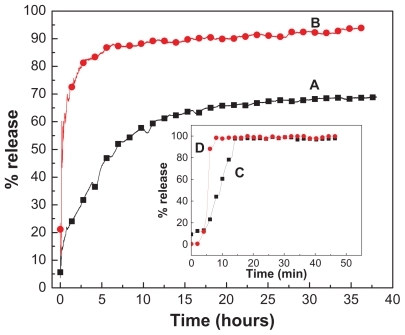
In order to obtain more information on the release behavior of EA from EAN, zeroth-, first-, pseudo-second-order kinetics and parabolic diffusion, were chosen to investigate the release kinetics of EA from the nanohybrid. The equations are given in . On the basis of the four models, the fitted results of EA release profiles are given in and . It can be seen that the pseudo-second-order model can be better fitted to the data of the EA release behavior than the other models. show the plots of t/qt versus t for the release of EA into Na2CO3 and Na3PO4 solution, respectively. For the Na2CO3, the correlation coefficient (R2) and k valves are 0.9985 and 0.0044, respectively, compared with 0.9996 and 0.0175, respectively for Na3PO4. The saturated release amount, correlation coefficient (R2) and rate constant for pseudo-second-order model are also given in . This study indicates that EAN synthesized in this work shows controlled-release properties.
Figure 9 Fitting of the data of EA released from the EAN into solution to the zeroth-, first-, pseudo-second-order kinetics, and parabolic diffusion for 0.1 M Na2CO3 (A, B, C, and D respectively) and Na3PO4 (E, F, G, and H, respectively).
Abbreviations: EA, ellagic acid; EAN, ellagic acid nanohybrid; ZnO, zinc oxide.
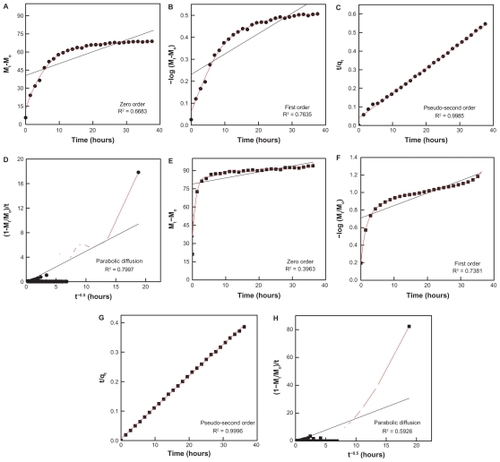
In vitro bioassay
and show the effect of free EA, EAN, and ZnO on the viability, using rat hepatocytes cells at various incubation times of 0, 0.5, 1, 3 and 6 hours and at a concentration of 25 μg/mL. As shown in , EA has a mild cytotoxic effect on the viability of the hepatocyte cells, similar to ZnO. Interestingly, the EAN also has a mild effect on the hepatocyte cells similar to that of free EA.
Table 3 Viability of hepatocytes during incubation with EA and EAN
Figure 10 The effect of EA, EAN, and ZnO on the viability of rat hepatocyte cells at the concentration of 25 μg/mL.
Abbreviations: EA, ellagic acid; EAN, ellagic acid nanohybrid; ZnO, zinc oxide.

A closer look at shows no significant toxic effect of EAN on the rat hepatocytes cells up to 6 hours, which indicates that EAN can be further used in the study using cancer cell lines.
Conclusion
This study shows that EA can be intercalated into the interlayer of ZLH under nonaqueous environment by direct reaction with ZnO for the formation of organic–inorganic nanohybrid. The resulting nanohybrid was obtained using 0.025 M EA. The obtained nanohybrid shows a basal spacing of 10.4 Å, which confirms the successful intercalation of EA into the interlayer of ZLH. In addition, FTIR and elemental analyses (CHNS) studies supported the intercalation of EA into ZLH interlayers for the nanohybrid formation, EAN. It was also found that the BET surface area declined from 6.4 to 3.6 m2/g when ZnO is transformed to EAN. The high loading of EA molecules inside the interlayers of about 58.8% is useful for controlled-release purposes, and the controlled-release study showed the drug active, EA was released in a controlled manner. The EAN has a mild effect on the hepatocyte cells similar to its counterpart, free EA, which indicates that the EAN can be further used in the study on cancer cell lines.
Acknowledgment
Funding for this research was provided by the Ministry of Higher Education of Malaysia (MOHE) under grant No. 05-03-10-1035 RUGS (Vot 9199644).
Disclosure
The authors declare no conflicts of interest in this work.
References
- TrikeriotisMGhanotakisDFIntercalation of hydrophilic and hydrophobic antibiotics in layered double hydroxidesInt J Pharm20073321–217618417070662
- AriZBMehtaALennardLBurroughsAKAzathioprine-induced myelosuppression due to thiopurine methyltransferase deficiency in a patient with autoimmune hepatitisJ Hepatol19952333513548551001
- TannerNSStamfordIFBennettAPlasma prostaglandins in mucositis due to radiotherapy and chemotherapy for head and neck cancerBr J Cancer19814367677717248158
- RosmanSCancer and stigma: experience of patients with chemotherapy-induced alopeciaPatient Educ Couns200452333333914998604
- AzzamTDombAJCurrent developments in gene transfection agentsCurr Drug Deliv20041216519316305382
- GarnettMCGene-delivery systems using cationic polymersCritical Rev Ther Drug Carrier Syst199916214720710706442
- BarbéCBartlettJKongLSilica particles: a novel drug-delivery systemAdv Mater2004162119591966
- BauerLABirenbaumNSMeyerGJBiological applications of high aspect ratio nanoparticlesJ Mater Chem2004144517526
- OzkanMQuantum dots and other nanoparticles: what can they offer to drug discovery?Drug Discov Today20049241065107115582795
- ChengXKuhnLChemotherapy drug delivery from calcium phosphate nanoparticlesInt J Nanomedicine20072466767418203433
- ShenoyDFuWLiJSurface functionalization of gold nanoparticles using hetero-bifunctional poly (ethylene glycol) spacer for intracellular tracking and deliveryInt J Nanomedicine200611515716467923
- PopovAMLozovikYEFioritoSYahiaLHBiocompatibility and applications of carbon nanotubes in medical nanorobotsInt J Nanomedicine20072336137218019835
- O’FarrellNHoultonAHorrocksBRSilicon nanoparticles: applications in cell biology and medicineInt J Nanomedicine20061445147217722279
- WuXTanYMaoHZhangMToxic effects of iron oxide nanoparticles on human umbilical vein endothelial cellsInt J Nanomedicine2010538539920957160
- XuZPWalkerTLLiuKCooperHMLuGQMBartlettPFLayered double hydroxide nanoparticles as cellular delivery vectors of super-coiled plasmid DNAInt J Nanomedicine20072216317417722544
- XuZPLuGQMaxNHydrothermal Synthesis of Layered Double Hydroxides (LDHs) from Mixed MgO and Al2O3: LDH Formation MechanismChem Mater200517510551062
- LiuXWordenJGDaiQZouJWangJHuoQMonofunctional gold nanoparticles prepared via a noncovalent interaction based solid phase modification approachSmall20062101126112917193575
- BerriozabalGde MiguelYRSynthesis and characterisation of silica nanoparticles bearing different functional groups obtained via a two stage methodPhysica Status Solidi C2010711–1226922696
- AjatMMohdMYusoffKHusseinMZSynthesis of glutamate-zinc- aluminium-layered double hydroxide nanobiocomposites and cell viability studyCurr Nanosci200844391396
- RivesVLayered Double Hydroxides: Present and FutureNew YorkNova Science Pub Inc2001
- ArizagaGGCSatyanarayanaKGWypychFLayered hydroxide salts: synthesis, properties and potential applicationsSolid State Ionics200717815–1811431162
- HusseinMZGhotbiMYYahayaAHAbdRahmanMZSynthesis and characterization of (zinc-layered-gallate) nanohybrid using structural memory effectMater Chem Phys20091131491496
- ChoyJHShinJLimSYOhJMOhMHOhSCharacterization and stability analysis of ZnO nanoencapsulated conjugated linoleic acidJ Food Sci2010756N636820722942
- CursinoACTGardolinskiJWypychFIntercalation of anionic organic ultraviolet ray absorbers into layered zinc hydroxide nitrateJ Colloid Interface Sci20103471495520378120
- ChoyJHKwakSYParkJSJeongYJPortierJIntercalative nanohybrids of nucleoside monophosphates and DNA in layered metal hydroxideJ Am Chem Soc1999121613991400
- HwangSHHanYSChoyJHIntercalation of functional organic molecules with pharmaceutical, cosmeceutical and neutraceutical functions into layered double hydroxides and zinc basic saltsBulletin- Korean Chemical Society200122910191022
- RoubaSRabuPDrillonMSynthesis and characterization of new quasi-one-dimensional Mn(II) hydroxynitrates (MnxZn1-x)(OH)(NO3) H2O (x = 0.53, 1.00)J Solid State Chem199511812832
- StahlinWOswaldHRThe crystal structure of zinc hydroxide nitrate, Zn5 (OH)8 (NO3) 2.2 H2OActa Crystallogr B1970266860863
- PetrovKLyubchovaAMarkovLSynthesis and thermal decomposition of magnesium hydroxide nitratesPolyhedron19898810611067
- RajamathiMKamathPVUrea hydrolysis of cobalt (II) nitrate melts: synthesis of novel hydroxides and hydroxynitratesInternational Journal of Inorganic Materials200137901906
- StratiAPapoutsiZLianidouEMoutsatsouPEffect of ellagic acid on the expression of human telomerase reverse transcriptase (hTERT) α+ β+ transcript in estrogen receptor-positive MCF-7 breast cancer cellsClin Biochem20094213–141358136219501078
- LossoJNBansodeRRTrappeyAIn vitro anti-proliferative activities of ellagic acidJ Nutr Biochem2004151167267815590271
- KimSNishimotoSKBumgardnerJDHaggardWOGaberMWYangYA chitosan/[beta]-glycerophosphate thermo-sensitive gel for the delivery of ellagic acid for the treatment of brain cancerBiomaterials201031144157416620185170
- KimSLiuYGaberMWBumgardnerJDHaggardWOYangYDevelopment of chitosan–ellagic acid films as a local drug delivery system to induce apoptotic death of human melanoma cellsJ Biom Mater Res B Appl Biomater2009901145155
- MoriokaHTagayaHKarasuMKadokawaJChibaKEffects of zinc on the new preparation method of hydroxy double saltsInorg Chem1999381942114216
- HusseinMZHashimNYahayaAHZainalZSynthesis and characterization of [4-(2,4-dichlorophenoxybutyrate)-zinc layered hydroxide] nanohybridSolid State Sciences2010125770775
- NakayamaHHatakeyamaATsuhakoMEncapsulation of nucleotides and DNA into Mg-Al layered double hydroxideInt J Pharm20103931–2105112
- HusseinMZJaafarAMYahayaAHZainalZThe effect of single, binary and ternary anions of chloride, carbonate and phosphate on the release of 2, 4-dichlorophenoxyacetate intercalated into the Zn-Al-layered double hydroxide nanohybridNanoscale Res Lett20094111351135720628454
- PressREHardcastleDSome physico chemical properties of ellagic acidJ Appl Chem1969199247251
- GuZThomasACXuZPCampbellJHLuGQIn vitro sustained release of LMWH from MgAl-layered double hydroxide nanohybridsChem Mater2008201137153722
- PandaHSSrivastavaRBahadurDIn-vitro release kinetics and stability of anticardiovascular drugs-intercalated layered double hydroxide nanohybridsJ Phys Chem B200911345150901510019831399
- DongLYanLHouWGLiuSJSynthesis and release behavior of composites of camptothecin and layered double hydroxideJ Solid State Chem2010183818111816
- KongXShiSHanJZhuFWeiMDuanXPreparation of glycy- l-tyrosine intercalated layered double hydroxide film and its in vitro release behaviorChem Eng J20101572–3598604
- SomchitNHassimSMSamsudinSHItraconazole and fluconazole-induced toxicity in rat hepatocytes: a comparative in vitro studyHum Exp Toxicol20022114312046723
- MarshallADCaldwellJInfluence of modulators of epoxide metabolism on the cytotoxicity of trans-anethole in freshly isolated rat hepatocytesFood Chem Toxicol19923064674731500033
- SomchitNWongCWZurainiAInvolvement of phenobarbital and SKF 525A in the hepatotoxicity of antifungal drugs itraconazole and fluconazole in ratsDrug Chem Toxicol200629323725316777703
- MarangoniRRamosLPWypychFNew multifunctional materials obtained by the intercalation of anionic dyes into layered zinc hydroxide nitrate followed by dispersion into poly(vinyl alcohol) (PVA)J Colloid Interface Sci2009330230330919081109
- NewmanSPJonesWComparative study of some layered hydroxide salts containing exchangeable interlayer anionsJ Solid State Chem199914812640
- XingfuZZhaolinHYiqunFSuCWeipingDNanpingXMicrospheric organization of multilayered ZnO nanosheets with hierarchically porous structuresJ Phys Chem C2008112311172211728
- HasegawaMTerauchiMKikuchiYDeprotonation processes of ellagic acid in solution and solid statesMonatsheftefür Chemie/Chemical Monthly20031346811821
- YangJHHanYSParkMParkTHwangSJChoyJHNew inorganic-based drug delivery system of indole-3-acetic acid-layered metal hydroxide nanohybrids with controlled release rateChem Mater2007191026792685
- NayeemNKarvekarMDIsolation of phenolic compounds from the methanolic extract of TectonagrandisResearch Journal of Pharmaceutical, Biological and Chemical Sciences201012221225
- BindraRSSattiNKSuriOPIsolation and structures of ellagic acid derivatives from Euphorbia acaulisPhytochemistry198827723132315
- BanaitJSSinghBKaurHElectrochemical synthesis of zinc (II) phenoxides and their coordination compoundsPortugaliae Electrochimica Acta2007254435442
- RoccaECailletCMesbahAFrancoisMSteinmetzJIntercalation in zinc-layered hydroxide: Zinc hydroxyheptanoate used as protective material on zincChem Mater2006182661866193
- SingKSWThe use of gas adsorption for the characterization of porous solidsColloids Surf1989381113124
- HusseinMZbHwaTKSynthesis and Properties of Layered Organic–inorganic Hybrid Material: Zn-Al layered double hydroxide– dioctylsulfosuccinate nanocompositeJ Nanopart Res200023293298
- SmithRASemiconductors2nd volCambridge, UKCambridge University Press1978
- RoussetJSaucedoELincotDExtrinsic doping of electrodeposited ZnO films by chlorine for transparent conductive oxide applicationsChem Mater2009213534540

